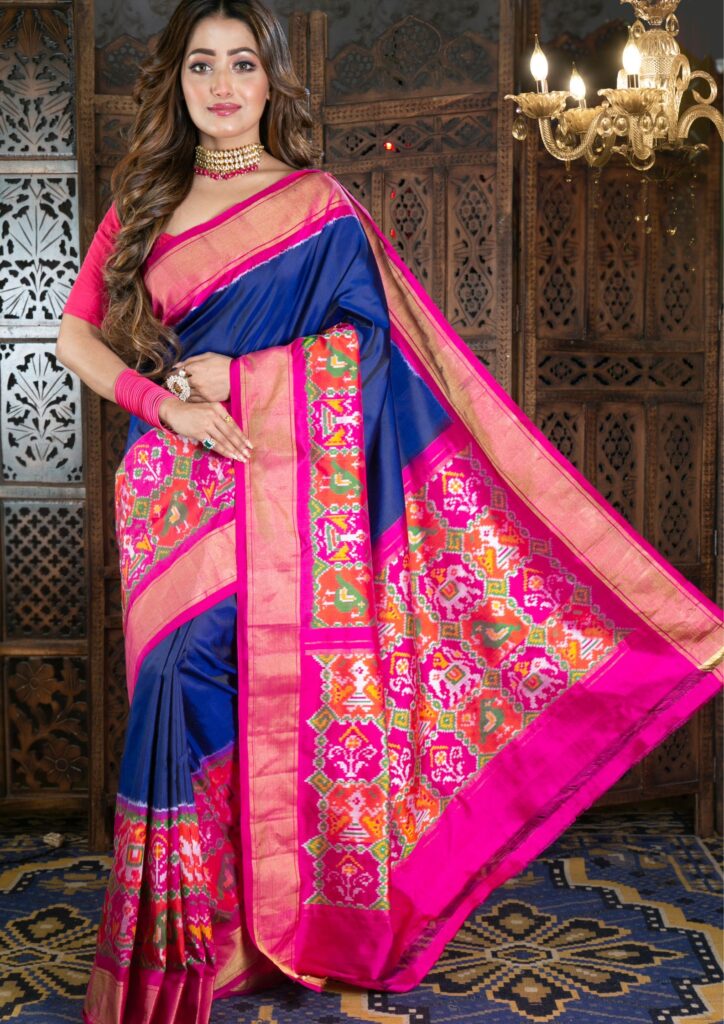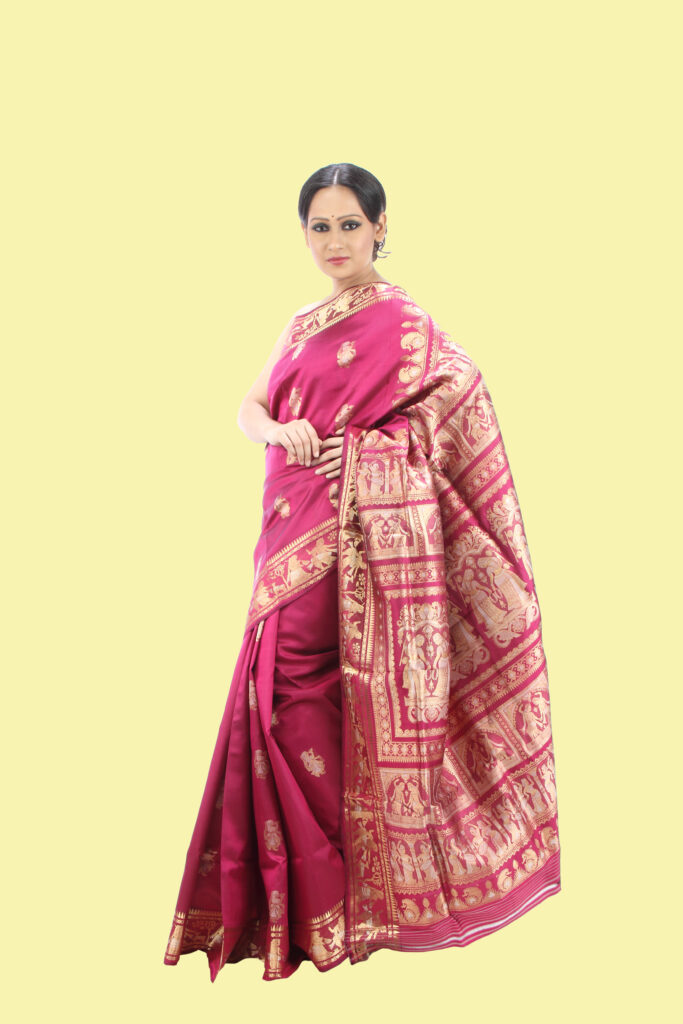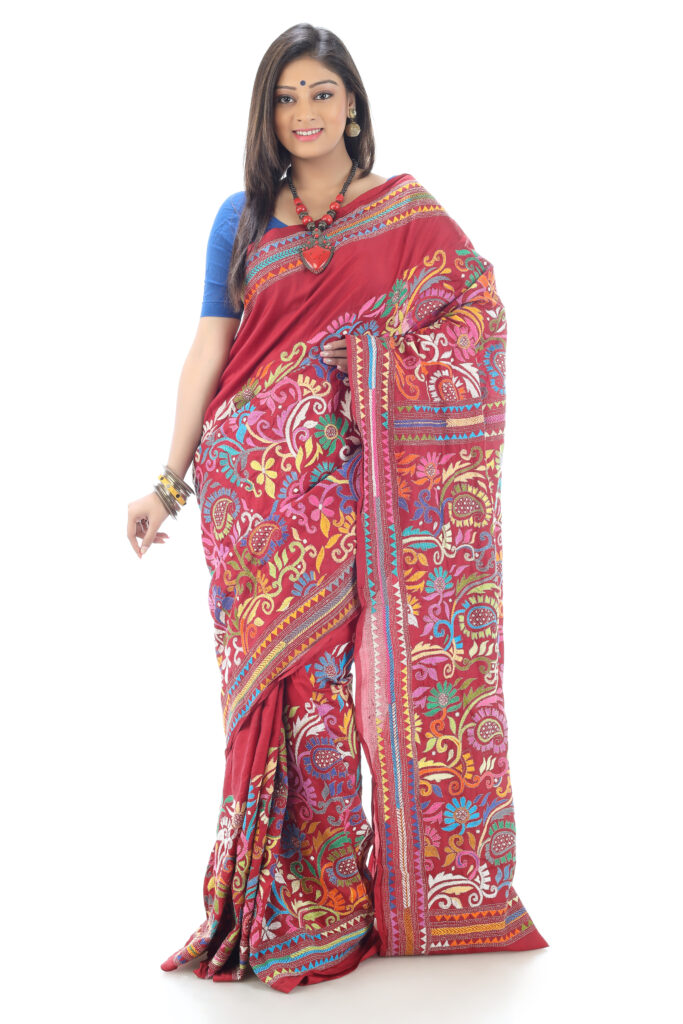First fragment of Indian hand-loom was excavated from the parts of Egypt. After that, finely woven and dyed cotton fabrics were found in Mohenjo Daro (Indus Valley Civilization). There were some more excavations that speak of the golden history of Indian hand-loom. With so many varieties of handloom from different states, India has collected a precious wealth of innovation.
Handloom sarees have a rich history in India, and they are considered a valuable part of the country’s cultural heritage. Each region in India has its own unique style of handloom saree, reflecting the local traditions, craftsmanship, and weaving techniques.
The tradition of handloom weaving in India dates back thousands of years. It is believed that the art of weaving was introduced to India around 5000 BC. Handloom sarees are traditionally made on a hand-operated loom, where the weaver manually interlaces the threads to create intricate patterns and designs.
Saree is the piece de resistance attire of Indian couture; an ever loved quintessence of wardrobe of women of all ages.
This Indian ethnic attire has garnered attention when it comes to style, its charm has gone boundless, even a women from foreign lands loves to drape in Indian sari.
Versatility of saree is something that makes this Indian traditional attire, a masterpiece with a unusual trait of adding extraordinary allure.
Ladies are poured with mammoth of choices in fabrics, colour, designs, prints, embroideries and styles.
With a huge variety of designs, printing techniques, weaving art and materials used, the field of Indian hand loom has created magic all over the world. Each and every state of Indian territory has a gift of designer handlooms to offer. Chanderi from Madhya Pradesh,
Patola from Hyderabad and Bishnupuri Baluchuri from West Bengal, Katha From Shantaniketan, Brocade, Uppada, Benarasi from Banaras, Kancheevuram from South India and Jacquard from Uttar Pradesh are some of the jewels that have been dazzling all over the world.



Here are some notable handloom saree varieties from different states in India:
Banarasi Silk Saree (Uttar Pradesh): Banarasi silk sarees are known for their luxurious silk fabric and intricate zari work. They are crafted in Varanasi (formerly known as Banaras) and are highly sought after for weddings and special occasions.
Kanjeevaram Silk Saree (Tamil Nadu): Kanjeevaram sarees, also known as Kanchipuram sarees, are woven in the town of Kanchipuram in Tamil Nadu. They are characterized by their rich silk fabric, vibrant colors, and intricate gold thread work.
Baluchari Saree (West Bengal): Baluchari sarees are crafted in the town of Baluchar in West Bengal. They are known for their intricate weaving, depicting mythological scenes and stories from epics like the Ramayana and Mahabharata.
- One of the most prominent offerings from Bangalore Silks is the Mysore silk saree. Mysore silk is known for its softness, vibrant colors, and exquisite gold zari work. These sarees are adorned with intricate motifs, floral patterns, and traditional designs, making them a popular choice for weddings, festivals, and special occasions.Another noteworthy saree variety from Bangalore Silks is the Kanjeevaram silk saree. Kanjeevaram sarees are renowned for their opulence, durability, and rich heritage. They are characterized by their heavy silk fabric, vibrant colors, and intricate gold thread work. Bangalore Silks showcases a wide range of Kanjeevaram sarees, each showcasing the distinctive motifs and designs associated with this traditional style.
- Kantha silk is a type of traditional Indian silk fabric that is handwoven and embroidered with intricate designs. Bishnupur, located in the Bankura district of West Bengal, India, is renowned for its exquisite Kantha silk work.The craft of Kantha embroidery has a rich history in the region, with Bishnupur being one of the major centers for its production. Kantha silk sarees, dupattas, and other garments from Bishnupur are highly sought after for their unique beauty and craftsmanship.
These are just a few examples, and there are many more varieties of handloom sarees from different regions of India. Each saree has its own unique weaving technique, design elements, and cultural significance, making them a cherished part of India’s textile heritage. The Indian government has taken initiatives to promote and preserve these handloom traditions, ensuring the continued production and appreciation of these exquisite sarees.
